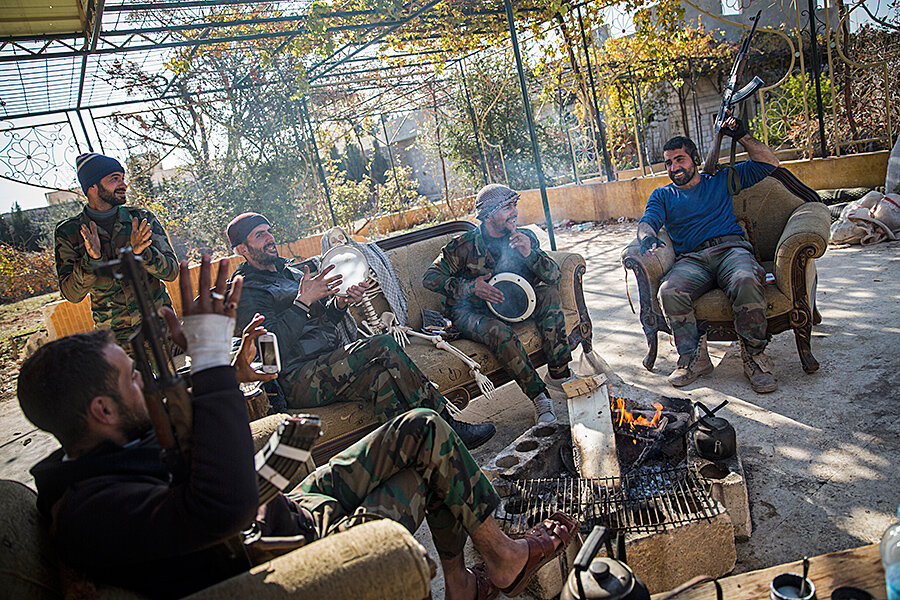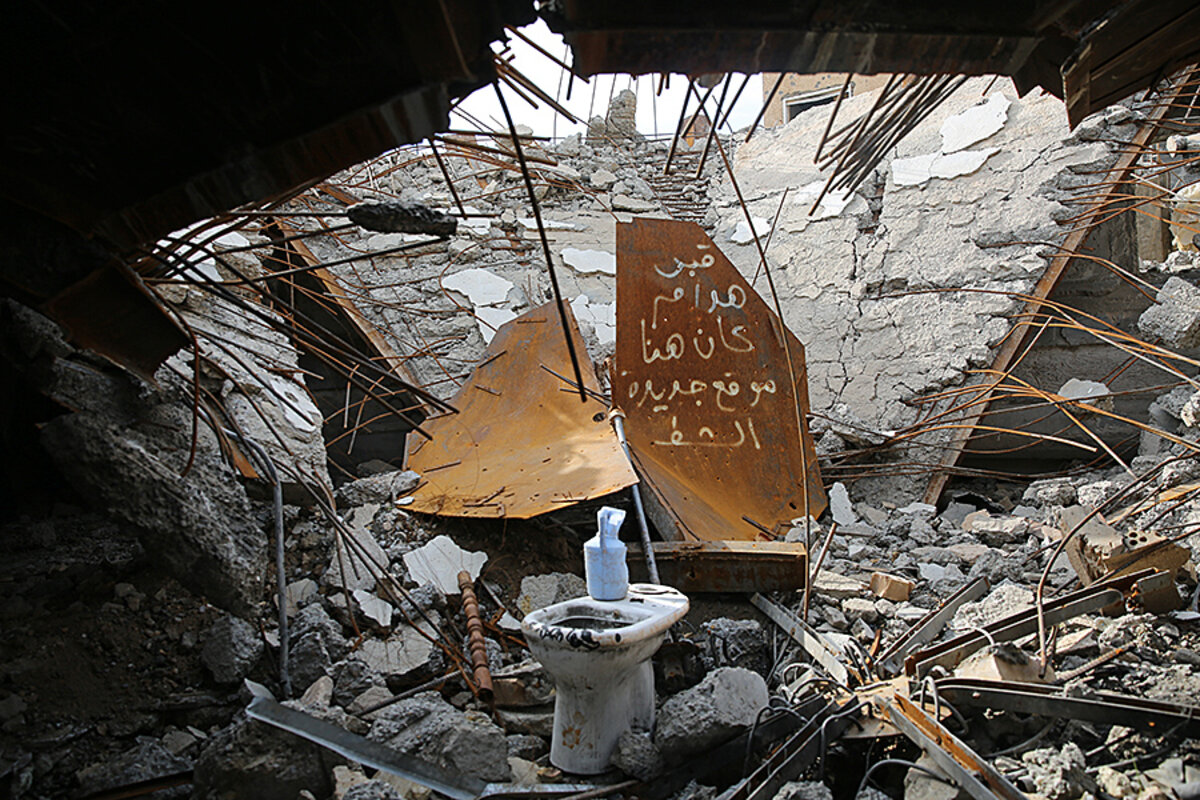Iranian war photographers: what makes them click
Loading...
| Tehran, Iran
The young Iranian war photographer can’t keep track of the close calls he’s had on the front lines in Syria.
“It’s always scary, when bullets are coming from everywhere, from left and right and from the sky,” says Ali Khara, a freelancer who has made 11 trips to Syria and has a taste for the trenches. “The only place bullets don’t come from is the ground.”
Rockets have landed close to Mr. Khara and killed his friends. A grenade aimed by an Islamic militant bounced off a window grate beside him and exploded in an alley below. And the shooting – and the special challenges of being an Iranian photographer covering Iran’s wars in Syria and Iraq – never seems to stop.
Iranian war snappers are a rare breed, partly because they get virtually no support. Photo editors are reluctant to finance high-risk trips with no guaranteed result; Iranian forces on the ground often don't want to deal with people lurking about with cameras.
For these photographers, too, there is an added danger: Capture by Islamic State (IS) fighters would, at best, be a coup for the jihadists. At worst, it could lead to their beheading.
For the determined few, the perilous journey requires spending their own cash or borrowing. Some sneak time away from regular jobs. Others carefully cultivate front-line contacts among those fighters who weigh the glory of having their exploits photographed over the risk of having a high-value target beside them.
“Any photographer comes with their own money and their own passion,” says Khara, a slight 26-year-old with a thin beard, three leather bands on his wrist, and eyes that radiate. “But it is very difficult. And it is even more difficult as an Iranian.”
“Whatever I was seeing [in Syria] gave me the motivation to stay there.… I really wanted to find the reality,” says Khara. He says he found children in “unacceptable” circumstances, which gave him an incentive “to show what has not been shown, at least in my own country.”
“It’s had some effect on my soul; now it’s definitely changed my emotions,” says Khara. “The worst thing that affects me most is the killing of innocent women and children in this war. They made no decision to fight, but they are in the middle of it.”
Where history is being made
His passion is echoed by Mohammed Hossein Velayati, a heavyset photographer with a thick black beard who has made four trips to Iraq. All those trips were made on his own dime and during holiday from his usual job as a news photographer for Fars News Agency.
“We are a generation that is new to doing this, and they don’t support us very much. Working like this is very tough,” says Mr. Velayati, speaking of the reluctance of Iranian news agencies to send reporters into harm’s way. “When we insist so much, they just say, ‘Don’t bother us.’ ”
Iranian news agencies sometimes do publish their photographs, but editors take care to ensure they have no obligation to buy, much less to help if anything goes wrong. And yet, as Iranians, these photographers have access to parts of the front line virtually off limits to their American and European brethren.
They share with them a burning desire to be where they sense history is being made, and to record it with a camera. Like freelancers everywhere, they survive close calls to get to difficult and dangerous places, while scrabbling for cash and trying to show a different reality. From Aleppo and Damascus in Syria to Tikrit in Iraq, some of their images reveal a rarely seen intimacy.
The five-year war in Syria, which is believed to have killed more than 250,000 people, has been marked by alleged atrocities attributed to Islamic militants and to barrel bombs dropped on rebel-held areas by forces loyal to President Bashar al-Assad. In this brutal conflict, the Iran- and Russia-backed loyalist side of the front is not often photographed.
In Iraq, Shiite militias organized by Iran’s Qods Force advisers have, with the Iraqi Army, led the fight against Islamic State militants, in a war that again is rarely seen outside.
A high-value target
Even though they are reporting on Iran’s side of both wars, they often meet with suspicion and find being Iranian can be a drawback, not an asset.
Velayati, for example, was collected by Iraqi troops from a front-line position – after a terrifying night of being besieged by IS, his first taste of war a year ago – because “IS was willing to lose 100 people to capture one Iranian,” he says.
To ease similar concerns in Syria that he is a high-risk target, Khara has sometimes passed himself off as a Tajik or Indian when working with the military. Usually he must rely on personal connections built since 2011 to pave the way to the front. Showing a press card, he says, “can make it worse.”
“It’s a very tight military environment there,” says Khara, who also freelances for Fars News Agency. Soldiers in Syria not used to seeing photographers of any nationality among them “would freeze when they saw me,” he says.
Normally Khara works with the Syrian Army, or with Hezbollah. But Iranian forces are trickier to deal with and scores of Iranian officers – including generals – have been killed in Syria and Iraq.
“Iranians are there and we have martyrs, but it is much more difficult to work with them,” says Khara, noting the depth of Iran’s involvement, but also the limits of working with such camera-shy units. “And if we do, then you can publish nothing.”
The Islamic Republic has a history of war photographers and filmmakers who cut their teeth during the Iran-Iraq war of the 1980s. A series of films from the front line called “Chronicles of Victory” documented the blending of Shiite religious fervor for a self-proclaimed “sacred defense” of Iran, with the revolutionary ideals of resistance and sacrifice.
The world 'in a photographic frame'
That legacy and those images – ingrained in Iran’s collective memory – is one reason Velayati, who was born as the war was ending, carries a camera at all. His father fought in the war, he says, recounting that “as we grew up we heard all the stories of the war … they revealed those places to us.”
His father was an avid photographer, so old cameras were around, as were albums with images of the war.
“Subconsciously, I saw everything in a photographic frame,” says Velayati.
“As a photographer, my duty is to reflect events as they are,” he adds, speaking of his work in Iraq. “It’s not very easy; you have to have contacts to work there."
When he did run into Iranian Qods Force officers, they sent him on his way.
Velayati has photographed the bones of Iraqi soldiers poking out of mass graves left by IS in Tikrit; a toilet that now sits on the destroyed remains of Saddam Hussein’s mausoleum; and the destruction of war. The night his militia unit was besieged near Balad, its commander was killed and he was so afraid that “my mouth could not swallow water."
On top of such fear he has also had to risk what every freelance photographer does: the chance of getting nothing of value on film, despite huge effort.
“I haven’t taken the photograph that will satisfy me yet,” says Velayati of his quest to be a war photographer. “I can tell you I am so prepared, I am taking the pictures in my mind right now.”







